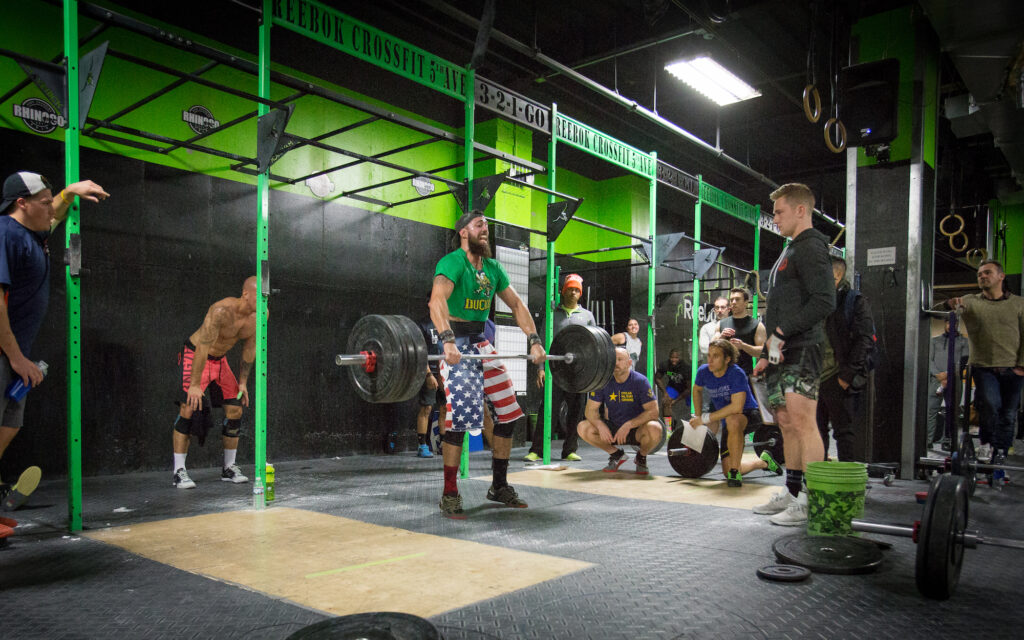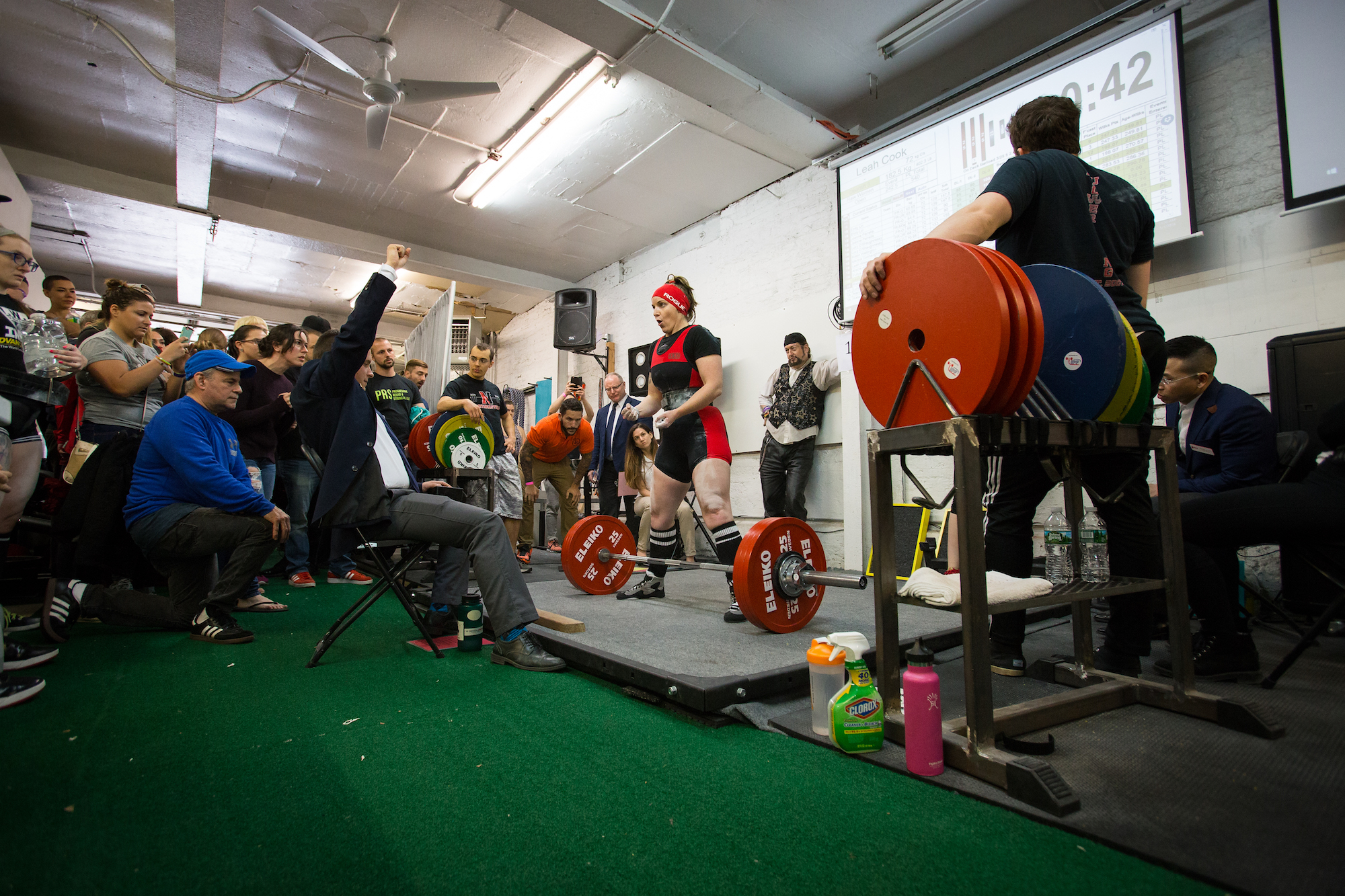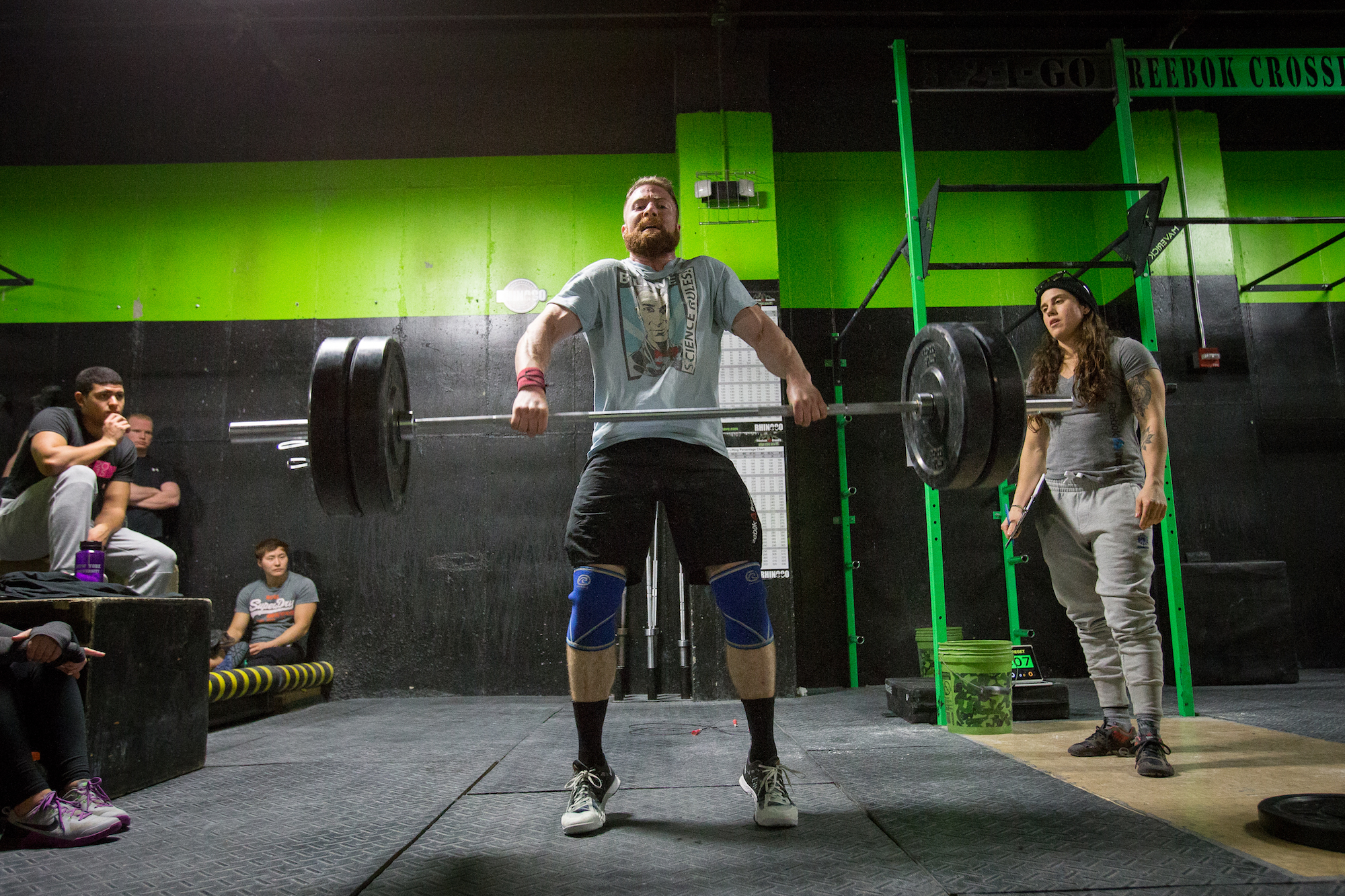Editors note: Katie Rose Hejtmanek, Ph.D. is a cultural anthropologist conducting research on the culture of strength sports in the United States. This is the fourth of an in-depth series introducing readers to her research and preliminary findings. This is an op-ed; all observations, data, and opinions come from her own research. You can read her first article here, her second here, and her third article here.
If you’re a fan of strength sports and want to look at their growth from a cultural, anthropological, and/or analytical perspective, we recommend this series.
On the first day of my in-depth ethnographic study at one of the CrossFit gyms I attend, a woman, Tracy I’ll call her, asked me if I thought CrossFit was a sport.
Alarm bells went off in my mind. Although I hadn’t been studying CrossFit or other strength sports long, I have been alive. And being alive in the United States means I have run across many people with very strong opinions about CrossFit, especially in relation to its status as a sport, especially with the surge in corporate support of and winnings for the 2016 CrossFit Games (all stuff I find quite remarkable, hence my research project). I knew this was a provocative question, and I was wading into dangerous water.
The other reason alarm bells went off is because as an anthropologist I am doing my best to withhold judgment about what is going on, to learn why people do what they do from their own perspective, not impose mine. We call this cultural relativism. Here I was trying to get to know people in a box and was asked point blank about my opinion on the activity.
“So,” Tracy asked, “as an athlete, do you consider CrossFit a sport?” I train to race short sprints in track and field. So my status as an “athlete,” or at least as someone who trains to compete in an activity that most would identify as a sport, seemed to bolster my opinion on the question at hand. It was clear by Tracy’s tone that, despite her adherence to CrossFit as a practice, she does not consider it a sport. Rock. Hard place.
For the record, I have nothing at stake if CrossFit is or isn’t considered a sport. (As a side note, USA Track and Field likes to claim it is the essence of all sports, origins worthy of the Greek gods with their #yourewelcome campaign. This is another example of an origin story. I don’t really have much at stake about this claim either. I’ll come back to why in a second.)
What I wanted to tell Tracy was an anthropologically informed answer about the history of what counts as sport and how power shapes this. But I didn’t, and I gave a weak answer about CrossFit reminding me of a modern, popular version of the decathlon or heptathlon. But as I mumbled this response, Tracy interrupted me, “Ha! See I told you!” to Nate standing next to me. I had stumbled into a long running debate between Nate and Tracy. Oh the perils of anthropological fieldwork! I then watched a 10 minute debate unfold, further convincing me that “CrossFit as a sport” is a contentious topic and people have very strong opinions about it.
The reason I don’t have a strong opinion or why nothing is really at stake for me in the debate is because what counts as sport has changed over time, many times. We have archaeological evidence from thousands of years ago of sporting activities throughout the world, many of these events may or may not count as sports today. What counts as a sport has as much to do with the activity at hand as it does about power in the world.
Those in power shape the narrative and practice of sport. Most importantly is that these things — history and power — illustrate that what counts as a sport changes all of the time! So the notion that something isn’t a sport could be made about the most important sports in the world and US today. These are all important aspects to remember about sport when deciding or debating which one is “real” or not. And because I missed my chance to tell Tracy this answer, I’m going to tell you.
Sport in the Archeological Record
Archeologists, a subset of the anthropology tribe, look for material remains to help us understand what humans were doing in the past. These material remains include pots, bones, seeds, middens (or garbage dumps), and other artifacts that the archaeologists interpret to tell the story of our ancient ancestors. Humans have lived as hunters and gatherers for most of human history. Despite popular ideas about hunting and gathering, the foraging life-style was not very labor intensive. Therefore, there was plenty of time for leisure activities. Could our hunting and gathering ancestors have played games or competed in sports? Archeologists believe that they did. In addition, sporting activities are known in ancient urban centers, such as Athens, Greece.
According to Kendal Blanchard (1995) sport can be found in prehistory from 4,000 BCE in North America and around 3,700 BCE in Mesopotamia through the material remains of “gaming devices.” BCE refers to “Before the Common Era” or what used to be referred to as BC; six thousand years ago our ancestors were using “gaming devices.” Archaeological evidence for wrestling and boxing in Mesopotamia (present day area of Syria, Iran, and Iraq) and ball games and nine pins in Egypt can be found 5,000 years ago. In 2,500-2,200 BCE our ancestors were doing acrobatics in Mesopotamia, and playing the Olmec ballgame in Mesoamerica (present day Central America).
Once we reach 4,000 years ago we have material remains that lead us to believe that humans were swimming, horse back riding, tumbling, throwing the javelin, jumping, shooting a bow and arrow, bull fighting, and playing ball games and marbles in Mesopotamia, Egypt, Mesoamerica, and Crete. By 1,500 BCE evidence of sport is found in India. By 1,000 BCE material remains suggest that people in Etruria (present day central Italy) were playing ball games, running, boxing, and wrestling. In North America in 500-1,500 CE (Common Era or what used to be AD), Native North Americans were playing “rubber” ball games, chunkey, hoop-and-pole, and a racket game (Blanchard 1995:101). And if you’re an anthropologist, you’ve likely heard about Pok-ta-pok (Mayan name) or Tlachtli (Aztec name) a ball game that has considerable archaeological evidence, including “stadiums.” And this survey does not even include the Greeks and their games! (For more information on that topic see the recent Wall Street Journal article by Daniel Kunitz.)
Archeologists have found material remains of a variety of sporting activities and games in prehistory (before written records) all over the world. And if we were betting people, we should probably bet that our ancestors, everywhere, have been playing games and competing in contests long before our archaeological evidence would suggest, too.
But which of these ancient sports would we count as sports today? More importantly, who gets to decide?
Sports and Power
Who gets to decide what counts as a sport is decided by power, not by three of us in a box in Manhattan. The power to decide the “realness” of sport, I believe, is based on at least three things: popularity, the associations that regulate the sports and the advertisers who support sporting events, and social context and cultural change, such as colonialism and feminist movements.
First, let’s take a look at popularity. What is the most popular sport in the world? If you answered “football” or “soccer” you would be correct, at least according to this website and this one. The lists on these website differ slightly but the next few most popular sports include cricket, table tennis, tennis, field hockey, baseball, golf, volleyball, and basketball. Therefore, if you are “counting” sports based on world-wide popularity many sports that are not popular in the United States, such as cricket or table tennis, would be considered real sports. And why not? Does the US have the final say on which sports count as real?
If you go to the country ranking on the website, American football ranks as the US’s most popular sport. American football is ranked either 9th or 13th on the list of most popular sports in the world. And yet in the United States, American football comes to dominate Sunday’s mainstream television channels every year from August to January, not to mention its creep onto Monday and Thursday. American football sure counts as a sport in the US, right? Do you know anyone who debates this?
But despite what the NFL and the millions-of-dollar advertisements might tell us, American football pales in comparison to other world-wide sports. For example, the Superbowl is fourth on the list of most watched sporting events. The FIFA World Cup takes the gold medal, the Olympics the silver, and the ICC Cricket World Championship the bronze. In other words, what counts as sport can be based on popularity, as people spend their time and money on particular sports and sporting events throughout the world. CrossFit is gaining in popularity, at least as an activity. Just check out where boxes are located world-wide.
That leads me to my second point: the financial power of associations. The National Football League is an extremely powerful entity in the US. The NFL gets to decide which football teams get to locate where and how much of tax-payer money will be spent on the construction of stadiums. Yes, the NFL influences not only our television schedules but the use of our tax dollars.
FIFA, Fédération Internationale de Football Association, governs soccer and the FIFA World Cup, the international soccer tournament held every four years to decide which country is the best at the sport. For wonderful dissections of FIFA’s power you can watch HBO’s Last Week Tonight with John Oliver. Oliver discusses how FIFA, a non-profit organization, profits off of the world’s love of soccer while paying no taxes to host countries. FIFA demanded that Brazil change their anti-alcohol laws so that Budweiser, one of its biggest sponsors, could be sold during the 2014 World Cup. In addition, FIFA created its own courts and justice system during the month long sporting event in South Africa. These courts, not local legal procedure, determined the punishment for crimes committed during the Cup. Think about this: what organizations are able to alter a nation-state’s legal system so that Anheuser-Busch can sell its product? FIFA, which regulates the most popular sport in the world, has this kind of power.
CrossFit® is sponsored by Reebok. It has the Games. And you can buy CrossFit® gear, just like you can buy a Messi or Richard Sherman jersey. It bills itself as “The Sport of Fitness™.” CrossFit® is itself a brand. If it isn’t a sport already, it is well on its way if we consider association marketing, and economic power.
And what about the International Olympic Committee (IOC), a committee that determines, among other things, which sports are “Olympic sports” and which ones aren’t: goodbye tug-of-war, hello curling. According to the Wikipedia page on Olympic sports, baseball and softball were dropped as Olympic sports in 2005 and golf and rugby sevens were added for the 2016 Summer Olympic Games. According to BarBend.com, it was just in 2000 in Sydney where women began competing in weightlifting. There is considerable cache for being an Olympic sport, as this is often an arbiter of what counts as sport. Sure CrossFit isn’t an Olympic sport. But neither is American football.
In other words, what counts as sports is related to the national and international associations that organize and regulate certain organized sports. The popularity of American football is largely related to the massive stadiums our tax dollars build and the amount of television time devoted to the sport. This increases the revenue of the NFL and the cycle of power and money continues. The same is true of FIFA except at an international level. The IOC gets to determine which sports will be included in the Olympics, and if it is in the Olympics it has to be a sport, right? These international and national sports organizations hold considerable power over what counts as sport. What’s to say that CrossFit won’t soon rival FIFA?
Finally, what counts as a sport is also shaped by social context and cultural change. As I talked about in my article on Instagram, sports adapt to various cultural circumstances. There is a classic documentary on cricket titled Trobriand Cricket: An Indigenous Response to Colonialism (for a short version see here). Cricket was used as a tool in British imperialism and colonialism, in the Trobriand Islands (and other places). This film shows how local people took the sport and refashioned it to make sense in their world. Is Trobriand Cricket a real sport? This documentary challenges us to think about what counts as sport, at least as sports are played in myriad ways throughout the world. My research will take me to other boxes in other countries to see how CrossFit is adapted to various local settings and cultural frameworks.
In 1972, the United States passed Title IX of the Education Amendments thanks to the feminist movement and individual gender equality champions, like tennis player Billie Jean King. Title IX prohibits discrimination based on sex in any federally funded education or training program and it led to the increasing equity of funding for boy’s and girl’s sports in public schools. A link can be made between the feminist movement in the 1970s, Title IX, an increase in girl’s sports in public schools, and the creation of professional athletic possibilities for women (such as the WNBA and equal pay for men and women in tennis).
As mentioned earlier, women could compete in the Olympics in weightlifting in 2000. Was women’s weightlifting a sport before then? Did it count? Was it real? CrossFit started gaining popularity around the same time, and the first CrossFit Games occurred in 2007. Perhaps there is a link between Olympic sport designation, women gaining increased access to the world of sports, professional and otherwise, in general and strength sports in particular, and the rise of CrossFit, especially female CrossFitters.
When discussing what counts as a real sport, I think it is important to take into account the historical and power dimensions of sport. I am not saying we should quit debating if CrossFit is a real sport, or even if American Football is. I’m just saying let’s add an anthropological perspective when we are deciding what counts as sport: a historical view that asks what is at stake, and for whom.
Editors note: This article is an op-ed. The views expressed herein are the authors and don’t necessarily reflect the views of BarBend. Claims, assertions, opinions, and quotes have been sourced exclusively by the author.


